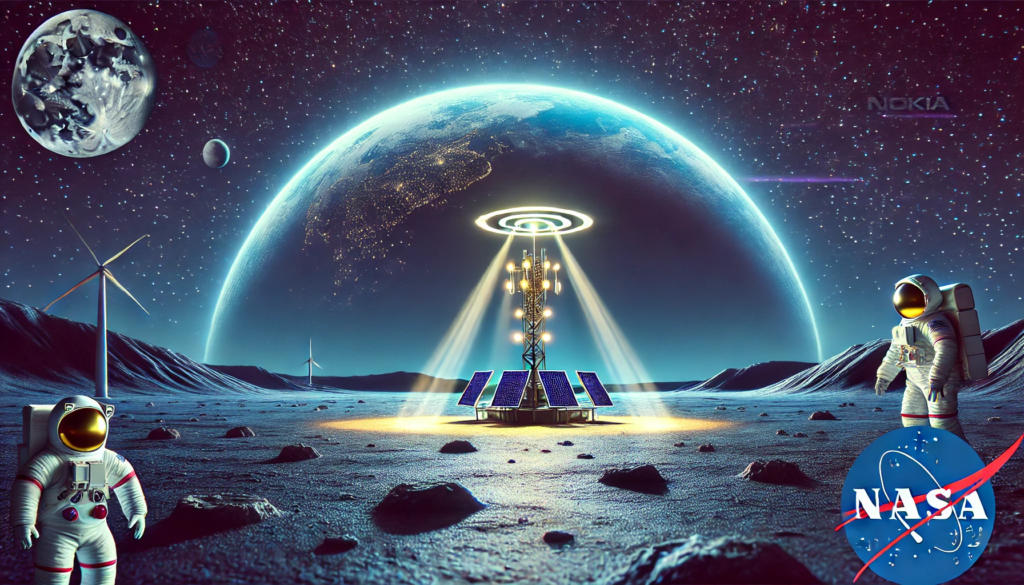
In a groundbreaking venture that bridges cutting-edge telecommunications and space exploration, Nokia and NASA have embarked on a mission to establish the first cellular network on the Moon. This ambitious project is not just about deploying technology—it’s about enabling a sustainable human presence on the lunar surface. By leveraging LTE/4G technology, the partnership aims to create a reliable communication infrastructure that will support a wide range of activities on the Moon, from scientific research and rover operations to future colonization efforts.
Why the Moon Needs a Cellular Network
For decades, lunar missions have relied on traditional radio-frequency communications to transmit data back to Earth. While these methods have served their purpose, they come with limitations in terms of bandwidth, reliability, and scalability. As NASA’s Artemis program sets its sights on a more permanent presence on the Moon, including establishing a lunar base and conducting long-term research, a robust communication system is essential.
A cellular network on the Moon offers several advantages:
- Increased Data Throughput:
With LTE/4G technology, scientists and astronauts can transmit high-definition video, telemetry data, and sensor readings more efficiently. This is crucial for tasks such as remote monitoring of experiments and real-time navigation. - Enhanced Reliability:
Traditional radio systems can be prone to interference and signal degradation. A cellular network provides a more stable and consistent connection, even in the Moon’s challenging environment. - Scalability for Future Missions:
As lunar operations grow, so too will the demand for more extensive and reliable communication networks. The LTE/4G system can be expanded and upgraded, paving the way for next-generation technologies such as 5G.
The Technology Behind the Mission
Nokia’s Bell Labs division has designed a compact, lightweight LTE/4G network that can withstand the harsh conditions of space. This “network in a box” includes the necessary base stations, antennas, and software, all optimized for low power consumption and high durability. The system will be deployed on the lunar surface using Intuitive Machines’ Nova-C lander, named Athena, as part of a larger lunar mission.
Key Features of Nokia’s Lunar Network:
- Durability and Ruggedness:
Built to survive the extreme temperatures, radiation, and vacuum of space, Nokia’s equipment is designed to function reliably in one of the harshest environments known to humankind. - Compact and Lightweight Design:
The entire network setup has been miniaturized to minimize payload weight, a critical factor in space missions. This efficient design makes it feasible to transport and deploy on the lunar surface. - Autonomous Operation:
Once deployed, the network can self-configure and operate autonomously, ensuring seamless connectivity for rovers, landers, and other devices without the need for constant human intervention.
Mission Objectives and Goals
The Nokia-NASA collaboration is part of NASA’s Artemis program, which aims to return humans to the Moon and establish a sustainable presence by the end of the decade. The cellular network will play a vital role in achieving several key objectives:
- Supporting Human and Robotic Operations:
Astronauts and robotic explorers will benefit from real-time communication, making it easier to conduct scientific experiments, navigate the lunar surface, and coordinate activities. - Facilitating High-Definition Video and Data Transmission:
The ability to stream HD video and rapidly transfer large datasets will enhance the quality of scientific research and provide Earth-based teams with better visibility into ongoing operations. - Enabling Long-Term Sustainability:
By laying the groundwork for advanced communication systems, the project supports the broader goal of creating a lunar infrastructure capable of supporting future missions to Mars and beyond.
Launch and Deployment Timeline
The Athena lander, carrying Nokia’s LTE/4G equipment, is scheduled for launch aboard a SpaceX Falcon 9 rocket from Kennedy Space Center. Once Athena reaches the lunar surface, it will deploy the network, which will begin providing coverage in a designated area. This initial deployment will serve as a proof-of-concept, demonstrating that cellular technology can function effectively on the Moon and be scaled up for future needs.
Potential Challenges and Solutions
While the project is a monumental step forward, it also comes with challenges. The Moon’s surface presents unique obstacles, such as extreme temperature fluctuations, micrometeorite impacts, and limited power resources. Nokia’s design team has addressed these issues by creating hardware that can endure temperature swings, resist radiation, and operate efficiently with minimal power input.
Another challenge is ensuring that the network can support multiple simultaneous users, including astronauts, robotic rovers, and stationary instruments. Nokia’s LTE/4G solution is designed to handle these demands, but continuous testing and optimization will be crucial as the project progresses.
Long-Term Implications
The deployment of a cellular network on the Moon marks a significant milestone in the evolution of space exploration technology. Beyond immediate mission support, this initiative has far-reaching implications:
- Advancing Space-Based Communications:
Demonstrating that LTE/4G technology can operate on the Moon opens the door for similar networks on other celestial bodies, such as Mars or asteroids. This technology could become a standard for extraterrestrial communication. - Boosting Earth-Based Innovations:
The challenges of developing space-hardened communication equipment often lead to breakthroughs that can be applied on Earth. From more efficient networking technologies to compact, durable hardware, the benefits of this project may extend well beyond lunar missions. - Inspiring Future Collaborations:
The success of the Nokia-NASA partnership sets a precedent for how government agencies and private companies can work together to tackle complex challenges. It demonstrates the value of leveraging industry expertise to achieve ambitious scientific goals.
Conclusion: A Giant Leap for Lunar Connectivity
The Nokia-NASA collaboration to establish the first cellular network on the Moon represents a bold step into the future of space exploration. By providing reliable, high-speed communication capabilities, this project supports NASA’s Artemis program and lays the foundation for sustainable human operations on the lunar surface. As the network becomes operational, it will serve as a critical infrastructure component, enabling astronauts and robotic explorers to work more efficiently, communicate seamlessly, and push the boundaries of what’s possible in space. This is not just a leap for lunar exploration—it’s a leap for technology, innovation, and human ingenuity.
